Summary Overview
Market Overview
The global cinnamon market is experiencing robust growth due to rising demand in food, beverage, pharmaceutical, and personal care sectors. Key factors driving the market include its use as a natural flavour enhancer, preservative, and its health benefits such as anti-inflammatory and antioxidant properties. Increasing global interest in natural and organic ingredients further boosts demand.
Our analysis highlights procurement trends, focusing on cost optimization through strategic sourcing and sustainability in cinnamon cultivation. The adoption of digital tools is helping stakeholders navigate pricing volatility caused by factors such as weather conditions and production costs.
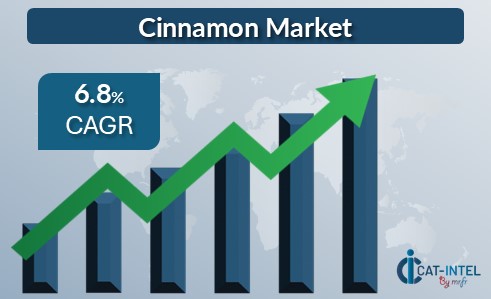
Market Size and Growth Rate
The cinnamon market is projected to grow at a CAGR of 6.8% from 2024 to 2032, with the Asia-Pacific region dominating in production and exports, especially Sri Lanka, Indonesia, and Vietnam.
Growth rate 6.8%
Sector Contributions
Food Industry Cinnamon is extensively used as a spice and flavouring agent in beverages, baked goods, and Savory dishes.
Pharmaceuticals and Cosmetics The use of cinnamon oil and extracts for their health benefits drives demand in these sectors.
Essential Oils The growing popularity of aromatherapy boosts cinnamon oil sales.
Technological Innovations
Advances in cultivation methods, including organic farming and water-efficient irrigation, are improving yields and sustainability. Digital procurement platforms allow for better supply chain visibility and vendor performance management.
Regional Insights
Asia-Pacific Dominates global production, with Sri Lanka producing premium-quality Ceylon cinnamon.
Europe Rising health consciousness is fuelling demand for organic cinnamon in dietary supplements and functional foods.
North America Increased use in convenience foods and beverages makes it a lucrative market.
Key Trends and Growth Drivers
Health Trends Recognition of cinnamon’s role in regulating blood sugar and promoting overall health is driving consumer demand.
E-commerce Expansion Online platforms make cinnamon products accessible to a wider audience.
Export Opportunities Rising global demand, especially in emerging markets, creates export potential.
Sustainability Outlook
Producers are increasingly adopting organic and sustainable farming practices to reduce environmental impact while meeting rising demand for eco-friendly products.
Key Suppliers
Major players include Bio foods Pvt Ltd and HDDES Group, known for their organic certifications and global export networks.
This data reflects current market dynamics and provides actionable insights for businesses aiming to enhance their procurement strategies in the cinnamon market.
Overview of Market Intelligence Services for the Cinnamon Market
Market reports highlight pricing trends, cost breakdowns, and procurement strategies to help businesses mitigate risks associated with pricing volatility. Strategic sourcing practices are essential for maintaining supply chain efficiency and competitiveness.
Procurement Intelligence for Cinnamon Market Category Management and Strategic Sourcing
In the cinnamon market, companies are focusing on enhancing procurement strategies to optimize costs, improve product availability, and achieve sustainability goals. Leveraging advanced tools for spend analysis and supply market intelligence, organizations are gaining better visibility into vendor performance and sourcing opportunities
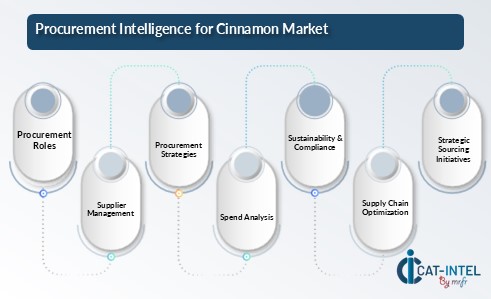
Pricing Outlook for Cinnamon Market Spend Analysis
The cinnamon market is witnessing dynamic pricing trends influenced by several critical factors, including rising demand for natural and organic spices, supply constraints due to climatic challenges, and increasing production costs. These elements contribute to a projected steady increase in cinnamon prices from 2024 to 2032, supported by global shifts in consumer preferences and agricultural trends.
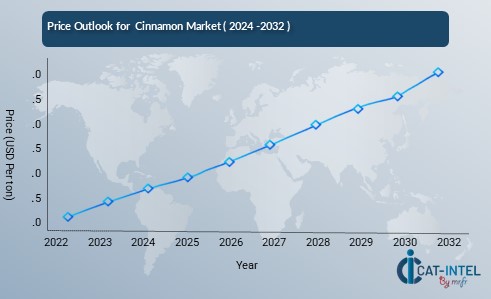
line chart illustrating the pricing outlook for the cinnamon market from 2024 to 2032. The graph depicts a steady upward trend, reflecting projected increases in cinnamon prices due to factors like rising demand, production costs, and climatic challenges.
Key Drivers of Pricing Trends
Surge in Global Demand Growing applications in the food, pharmaceutical, and personal care industries, especially for organic and health-oriented products, have significantly boosted cinnamon consumption globally.
Rising Production Costs Labor, land, and compliance with sustainable farming practices have escalated costs, impacting pricing structures across markets.
Climate Impact Fluctuating yields due to changing weather patterns in key producing regions like Sri Lanka and Indonesia contribute to price volatility.
Export Opportunities Expanding markets in Europe and North America are increasing the competitive pressures for premium cinnamon varieties like Ceylon and Saigon.
Cost Breakdown for the Cinnamon Market Cost saving opportunities
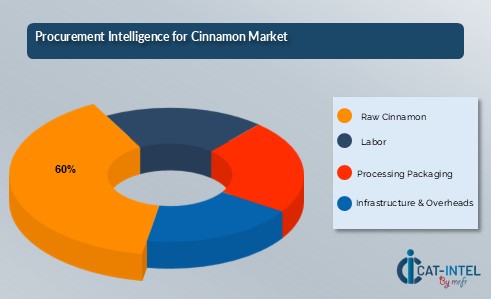
Raw Cinnamon (60%)
Description The primary cost component, covering the procurement of raw cinnamon varieties such as Ceylon and Cassia, sourced from key producers like Sri Lanka, Indonesia, and Vietnam. The costs are heavily influenced by demand, organic certification, and regional climatic conditions.
Labor (XX%)
Processing & Packaging (XX%)
Infrastructure & Overheads (XX%)
Cost Saving Opportunity Negotiation Lever and Purchasing Negotiation Strategies
In the cinnamon market, optimizing procurement can lead to significant cost savings. Strategies like collaborative purchasing allow for bulk discounts, while sustainable farming practices reduce the use of water and chemicals. Precision agriculture technologies, such as drones and data analytics, help manage resources efficiently. Vertical integration lowers processing costs, and energy-efficient processing facilities reduce utility expenses. Additionally, transportation optimization and marketing cooperatives help cut logistics and advertising costs, enabling producers to enhance profitability while managing expenses effectively.
Supply and Demand Overview of the Cinnamon Market Demand-Supply Dynamics and Buyer Intelligence for Effective Supplier Relationship Management (SRM)"
The cinnamon market is experiencing steady growth, driven by increasing demand in both food and non-food applications. Rising consumer interest in natural Flavors, wellness products, and functional foods are fuelling this demand. Additionally, the use of cinnamon in health and wellness products, including teas, supplements, and natural sweeteners, is amplifying its popularity.
Demand Factors
Health Awareness Cinnamon is recognized for its antioxidant and anti-inflammatory properties, contributing to its popularity in functional foods and supplements.
Flavors Versatility Cinnamon's versatility across various cuisines and products, from baked goods to beverages, supports consistent demand across global markets.
Natural and Organic Trends The rising preference for organic and natural ingredients has made cinnamon a staple in clean-label products.
Culinary Applications Increased demand for spiced and exotic Flavors in food products, especially in the snack and bakery sectors, enhances cinnamon consumption.
Supply Factors
Source Diversity The major producers of cinnamon include Sri Lanka, India, and Indonesia, with Cinnamomum verum (true cinnamon) primarily cultivated in Sri Lanka. This diversification ensures a steady global supply.
Farming Innovations New agricultural practices, such as sustainable cultivation and harvesting methods, have helped maintain quality and consistency in supply.
Supply Chain Fluctuations Weather-related events, political instability, and supply chain disruptions can affect cinnamon production, especially in key growing regions like Sri Lanka and Indonesia.
Market Competition The growing competition from synthetic flavourings and other natural spices impacts pricing and availability in global markets.
Regional Demand-Supply Outlook Cinnamon Market
The image shows growing demand for Cinnamon in both Asia and Europe, with potential price increases and increased competition
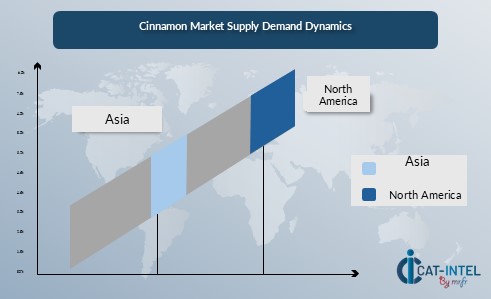
Asia and Europe Lead Cinnamon Demand
Th cinnamon market is influenced by significant demand from Asia and Europe, driven by growing interest in health products, natural ingredients, and culinary uses.
Asia As Key Market for Cinnamon
Leading Consumers Countries such as India, China, and Indonesia are major consumers, where cinnamon is used in a variety of traditional dishes, beverages, and health remedies.
Rising Health Awareness Increased awareness about cinnamon’s health benefits, such as its anti-inflammatory properties, is driving demand across the region.
Market Expansion As economies in Asia grow, the demand for processed and packaged food, including cinnamon-flavoured products, is also rising.
Asia remains a key hub Cinnamon market and its growth

Supplier Landscape Supplier Negotiations and Strategies
The cinnamon market, like the almond market, has a diverse supplier landscape comprising both global and regional players. The cinnamon supply chain includes essential raw material suppliers, agricultural service providers, and distributors, with players focused on cultivation, processing, and packaging. The market is also driven by a strong relationship between cinnamon producers and these suppliers, which help ensure a steady supply of high-quality cinnamon for food, beverage, pharmaceutical, and cosmetic industries.
Key suppliers in the cinnamon market include
Risun Bio-Tech Inc.
Cinnatopia
Monterey Bay Spice Company
The Organic Cinnamon
Ceylon Spice Company
Elite Spice
Natural Spices of Grenada
McCormick & Company
Lemur International Inc.
New Lanka Cinnamon Pvt. Ltd.
G.P. de Silva & Sons International (Pvt.) Ltd.
Future Ceuticals
Kahawatte Plantations PLC
High Plains Spice Company
Great American Spice Co.
Key Development Procurement Category significant development
Category |
Significant Development |
Impact/Benefit |
|
Sustainable Sourcing |
Increased focus on organic and Fair Trade-certified cinnamon. |
Enhances product appeal in health-conscious and eco-conscious markets. |
|
Automation in Processing |
Adoption of automated processing and packaging technology. |
Reduces labour costs, increases efficiency, and improves product consistency. |
|
Vertical Integration |
Direct partnerships with cinnamon farmers to control supply chain. |
Ensures a stable, high-quality supply while reducing reliance on third-party suppliers. |
|
Technology Adoption |
Integration of data analytics and IoT for improved crop monitoring and supply chain management. |
Optimizes yield, tracks quality, and enhances logistics efficiency. |
|
Diversified Sourcing |
Expanding sourcing from Sri Lanka and Indonesia to include other regional suppliers. |
Reduces dependency on single regions and mitigates supply risks. |
|
Regulatory Compliance |
Increasing adherence to international food safety and environmental standards. |
Boosts credibility and marketability in global markets, particularly in Europe and North America. |
|
Procurement Attribute/Metric |
Details |
Market Sizing |
The cinnamon market is projected to grow from USD 5.21 billion in 2023 to USD 8.63 billion by 2032, with a CAGR of 6.8% during the forecast period. |
Adoption of Cinnamon-Based Products |
The rising consumer preference for natural Flavors, health benefits, and the growth in the food and beverage industry is driving demand for cinnamon in snacks, beverages, and supplements. |
Top Strategies for 2024 |
Focus on expanding the use of cinnamon in health and wellness products, strengthening supplier partnerships, and leveraging technology for efficient supply chain management. |
Automation in Cinnamon Processing |
Around 35% of cinnamon processing units are adopting automated sorting, grinding, and packaging systems to improve efficiency and reduce operational costs. |
Procurement Challenges |
Key challenges include supply chain disruptions, price volatility due to climatic factors, and the need for sustainable and ethical sourcing practices. |
Key Suppliers |
Key players include McCormick & Company, Cinna Gen, Nestlé, and the Indonesian Spice Association, focusing on both bulk and value-added cinnamon products. |
Key Regions Covered |
Key markets include Asia-Pacific (Indonesia and Sri Lanka), North America, and Europe, with significant demand in the U.S., India, and the European Union. |
Market Drivers and Trends |
Growth is fuelled by the increasing popularity of cinnamon in health-conscious products, rising consumer interest in natural ingredients, and expanding culinary applications. |








